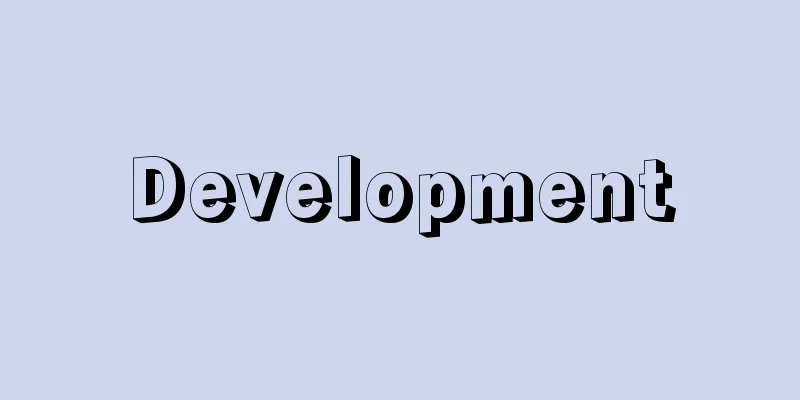Development

|
As a biological term, development is used in two different senses. One refers to the process by which the diverse life forms seen today have arisen over a long period of time from the first life forms that appeared on Earth, in other words, the historical development of biological species. This is called phylogeny. The other refers to the process by which an individual is created starting from a single cell during the life cycle of a multicellular organism, in other words, the process by which cells multiply and differentiate into complex, individual organisms. This is called ontogeny, and is what is usually meant when people simply talk about development. In the remainder of this article, we will explain ontogeny. [Kinoshita Seiichiro] Developmental processOntogenesis generally begins with sexual reproduction. First, gametes are produced by meiosis in the individual's body. The process up to the point where fertilization occurs is the same for animals and plants. In animals, the fertilized egg undergoes repeated cleavage, and the resulting blastomere becomes a hollow sphere. This is the blastula. Eventually, morphogenetic movements occur within the cell group, causing the archenteron to invaginate, and the blastula folds inward to become an embryo with a double wall. This is the sacula (gastrula). At this stage, the embryonic cells form three groups, called the ectoderm, mesoderm, and endoderm. Each germ layer is determined to become a specific organ or tissue in the future. For example, the ectoderm covers the outer surface of the body and produces the skin and its appendages, as well as the nervous system. The mesoderm produces muscles, heart, kidneys, internal skeleton, and mesenchyme. The endoderm forms the digestive tract, such as the stomach and intestines, and the associated digestive glands, such as the liver and pancreas. These processes vary slightly depending on the species of animal, but are basically the same. In seed plants, the starting point is also a fertilized egg, but the fertilized egg divides to produce an embryo with a shoot, root, and cotyledons inside the seed, which then goes into hibernation. Once germination has occurred, the growth of the plant body is limited to the tips of stems and roots through cell division, which is a major difference from animals. [Kinoshita Seiichiro] Mechanism of developmentCell proliferation and differentiation play a major role in individual development. As development progresses, the number of cells increases, but when it reaches a certain limit, proliferation stops and organs and tissues maintain a certain overall size. This is because cell proliferation is limited within an individual, but the nature of this limitation is still not well understood. The process by which various tissues arise within an embryo and are orderedly arranged to become an individual is called cell differentiation, and is the most fundamental aspect of the mechanism of development. Cells are inherently capable of expressing various characteristics, but it is understood that the cells that make up tissues within an individual selectively express only certain characteristics, resulting in the properties of the brain, muscles, liver, etc. In this way, cell proliferation and differentiation are limited within an individual. It can be said that an individual is only possible because of these restrictions. Development is the process of orderly restricting cell proliferation and differentiation within an embryo. In addition, each cell has life, and each individual has a higher life of its own; however, the life of an individual is essentially a force that limits the capabilities of a cell, and development is the process of elevating the life of a cell to the life of an individual. Within the embryo, certain tissues act on other tissues, resulting in cell differentiation, in a series of successive processes. This phenomenon is called induction. For example, in amphibians, a part called the dorsal lip of the blastopore invaginates inward when the sac embryo is formed, lining part of the ectoderm remaining on the outside, causing that part of the ectoderm to differentiate into neural tissue (first embryonic induction). Next, in the head, the neuralized tissue becomes the brain, and parts of that become the eyes, which are equipped with lenses and corneas. All of these are thought to be chains of induction. Within the embryo, various inductions occur, and complex tissues are formed. [Kinoshita Seiichiro] Developmental VariationsDevelopment is the process by which an embryo is created through this intricate coordination of cell proliferation and differentiation, but the basic mechanisms of development actually continue to function even after an individual has been created. For example, when an organism is injured, the previously dormant proliferation process begins to move again, and cells differentiate to create the original shape, before going dormant again. This is regeneration, and the ability of each animal varies from one animal to another, ranging from the ability to regenerate a single limb, like newts, to the ability to heal wounds, like humans. Regeneration can be seen as a partial repetition of development in adults. Some researchers view cancer as a failure of regulation of cell proliferation within an individual, resulting in abnormal differentiation. This also takes the position that the developmental mechanisms continue to function within the individual, and sees cancer as a failure of development. Also, an individual may pass through a larval form before becoming an adult. At this time, a drastic change (metamorphosis) occurs in the body structure. This can be seen as a kind of repetition of development. [Kinoshita Seiichiro] "Development: Its Mechanisms" by J.D. Ebert, translated by E. Okada and Setsuto Okada (1967, Iwanami Shoten) " "Developmentology" by I.B. Balinski, translated by Yujiro Hayashi (1969, Iwanami Shoten)" ©Tomita Hyakushu "> Toad Embryonic Development ©Masayoshi Umebayashi "> Embryonic development of shepherd's purse (1) ©Masayoshi Umebayashi "> Embryonic development of shepherd's purse (2) Source: Shogakukan Encyclopedia Nipponica About Encyclopedia Nipponica Information | Legend |
|
生物学用語としての発生は、二つの異なった意味で用いられる。一つは、地球上に最初に現れた生命から、長い年代の間に現在みられるような多様な生命形態が生じてきた過程、すなわち生物種の歴史的な発生をいう。これを系統発生とよぶ。もう一つは、多細胞生物の生活環のなかで、1個の細胞から出発して個体がつくられるまでの過程、すなわち細胞が増殖し、おのおのが分化を遂げて、複雑な有機体である個体になるまでをいう。これを個体発生とよび、普通、単に発生といえばこちらをさす。以下、本項では個体発生について解説する。 [木下清一郎] 発生の過程個体発生は有性生殖によって始まるのが一般的な形式である。まず、個体の体内で生殖細胞が減数分裂を行って配偶子がつくられる。続いて受精が行われるまでは動植物とも同じである。動物では受精卵は卵割を繰り返し、生じた割球は中空の球状体となる。これが胞胚(ほうはい)である。やがて細胞集団の中で形態形成運動がおこって原腸が陥入をおこし、胞胚は内部に折り畳まれ、二重の壁をもった胚となる。これが嚢胚(のうはい)(原腸胚)である。このころには胚細胞は三つの集団を形づくり、それらは外・中・内胚葉とよばれる。各胚葉は将来それぞれ特定の器官や組織となるよう決定されている。たとえば、外胚葉は体の外表面を覆って皮膚やその付属物をつくるほか、神経系などをつくる。中胚葉は筋、心臓、腎臓(じんぞう)、内部骨格、間充織などとなる。内胚葉は胃、腸などの消化管とこれに付属する肝臓、膵臓(すいぞう)などの消化腺(せん)をつくる。これらの過程は動物の種類が違えばすこしずつようすが違うが、基本的には共通である。 種子植物でも受精卵が出発点となることは同じであるが、受精卵が分裂して幼芽・幼根・子葉をもった胚が種子中につくられ、いったん休眠する。発芽すると植物体の成長は茎や根の先端などに局限して行われる細胞分裂による点が、動物と大きく違っている。 [木下清一郎] 発生の機構個体発生では細胞の増殖と分化が大きな役割を果たしている。発生が進行するにつれて細胞数は増えていくが、ある限度に達すると増殖は止まり、器官や組織はつり合いを保って、全体としてある大きさを保つ。個体の中では細胞の増殖はある制限を受けているためであるが、この制限の本質については現在でもよくわかっていない。また、胚の中にさまざまの組織が生じ、これが秩序正しく配列して個体となる過程を細胞の分化といい、発生の仕組みのなかではもっとも基本的な事柄である。細胞は本来さまざまの形質を発現する能力をもっているのであるが、個体の中で組織をつくっている細胞は、ある形質のみを選んで発現し、その結果、脳、筋、肝臓などの性質を表していると理解されている。このように、個体の中では細胞の増殖と分化とはある制限を受けている。この制限があって初めて個体が成り立っているともいえる。発生とは胚の中で細胞の増殖と分化を秩序だてて制限していく過程である。また、個々の細胞が生命をもっているうえに、個体は個体としての高次の生命をもっているわけであるが、個体の生命とはとりもなおさず細胞の能力を制限する力であって、発生とは細胞の生命を個体の生命に高めることである。 胚の中ではある組織がほかの組織に働きかけて、その結果として細胞分化がおこるという過程が次々に連なっている。この現象を誘導とよぶ。たとえば、両生類などでは、嚢胚ができる際に内部に陥入した原口背唇とよばれる部分が、外側に残っている外胚葉の一部を裏打ちして、その部分の外胚葉を神経組織に分化させる(第一次胚誘導)。続いて頭部では神経化した組織が脳となり、その一部が目となり水晶体や角膜を備えるようになる。これらはいずれも誘導の連鎖と考えられている。胚の中ではさまざまの誘導がおこりながら複雑な体制がつくられていく。 [木下清一郎] 発生の諸変異このように細胞の増殖と分化とが巧みに調和しつつ胚をつくりあげていく過程が発生であるが、発生の基本的な仕組みは実は個体がつくられたのちにも働き続けている。たとえば、けがをすると、それまで休止していた増殖の働きが動きだし、元の形をつくりあげるように細胞が分化してふたたび休止する。これが再生であって、動物によって能力に程度の差があり、イモリのように肢(あし)1本を再生できるものから、ヒトのように傷を治すぐらいまでのものまである。再生は成体での部分的な発生のやり直しとみることができる。 個体の中で細胞増殖の調節が働かなくなり分化にも異常をきたしたものとして癌(がん)をみようとする研究者がある。これもやはり個体の中で発生の仕組みが働き続けているとする立場であって、癌を発生の失敗とみるわけである。また、個体が成体になるまでに幼生の形を経ることがある。この際には体制に激烈な変化(変態)がおこる。これは、発生の一種の繰り返しともみることができる。 [木下清一郎] 『J・D・イバート著、岡田瑛・岡田節人訳『発生――そのメカニズム』(1967・岩波書店)』▽『I・B・バリンスキー著、林雄次郎訳『発生学』(1969・岩波書店)』 ©冨田百秋"> ヒキガエルの胚発生 ©梅林正芳"> ナズナの胚発生(1) ©梅林正芳"> ナズナの胚発生(2) 出典 小学館 日本大百科全書(ニッポニカ)日本大百科全書(ニッポニカ)について 情報 | 凡例 |
<<: Voice production (English spelling)
Recommend
Ryushi's New Theory
A representative work by Yamagata Tainii, a think...
Physalis pruinosa (English spelling) Physalispruinosa
…[Yoshiharu Iijima]. … *Some of the terminology t...
Lindernia crustacea (L.) F.Muell.
A weed that grows in slightly humid places such as...
Novum organum
A work by F. Bacon. It was first published in 1620...
Tadaki Tosa
Year of death: 19th May 1869 (28th June 1869) Year...
Stress - Stress
Speech sounds can be made stronger or weaker by th...
Vanadium Oxide - Vanadium Oxide
[ I ] Vanadium(II) oxide: VO (66.94). Also known ...
Kitasato Institute
A medical research institute. In 1892 (Meiji 25),...
Lake Magadi (English spelling)
A salt lake in southwestern Kenya, eastern Africa....
Kanhizakura - Kanhizakura
A deciduous tall tree of the Rosaceae family (APG...
Heritage Attribution War - Issankizoku Senso
...war in which France invaded the southern Nethe...
Shusui-shi
〘 noun 〙 A vassal of the Imperial Household Minist...
bâton percé (English spelling)
…An ancient stone tool made of bone and antler. I...
Hyoko Lake
This artificial lake is located in Agano City, Ni...
The Chronicles of Nobutane
The diary of the mid-Muromachi court noble Nakamik...









